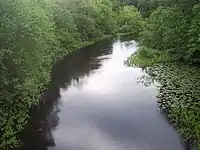Woonasquatucket River
The Woonasquatucket River (pronounced /wuːnˈɑːskwəˌtʌkɪt/, Algonquian for "where the salt water ends") is a river in the U.S. state of Rhode Island. It flows approximately 15.8 miles (25.4 km)[1] and drains a watershed of 130 km2 (50 sq mi).[2]
| Woonasquatucket River | |
|---|---|
 | |
| Location | |
| Country | United States |
| State | Rhode Island |
| County | Providence |
| Physical characteristics | |
| Source | |
| • location | North Smithfield, Rhode Island |
| Mouth | |
• location | Providence River |
• coordinates | 41.8267°N 71.4100°W |
| Length | 15.8 mi (25.4 km) |
| Basin size | 130 km2 (50 sq mi) |



Together with the Blackstone River to the north, the Woonasquatucket was designated an American Heritage River in 1998. Both rivers played active roles in the industrial revolution and the history of Rhode Island in the 19th century. Evidence of this industrial history remains in the fact that there are 18 dams along the river's length.[3]
Course
The river begins in the swamps west of Primrose Pond in North Smithfield and runs southeast past Primrose Pond to Stillwater Reservoir. Below the reservoir, the river continues southeast, providing water to numerous ponds, until going under Providence Place mall and joining the Moshassuck River in front of the One Citizens Plaza building in downtown Providence to form the Providence River. The lower part of the river, below Rising Sun Dam in Olneyville is tidal.
East of Interstate 95, the Woonasquatucket's original riverbed no longer exists and it has been diverted into a man-made channel underneath Providence Place Mall and through Waterplace Park. In Waterplace Park, the Woonasquatucket River is also used as part of Waterfire.
Crossings
Below is a list of all crossings over the Woonasquatucket River. The list starts at the headwaters and goes downstream.
- North Smithfield
- Greenville Road (RI 5/104)
- Douglas Pike (RI 7)
- Smithfield
- Farnum Pike (RI 5/104)
- Old Forge Road
- Farnum Pike (RI 5/104)
- George Washington Highway (RI 116)
- Capron Road
- Whipple Avenue
- Farnum Pike (RI 104)
- Esmond Street
- Esmond Mill Drive
- North Providence
- Angell Avenue
- Putnam Pike (U.S. 44)
- Allendale Avenue
- Johnston
- Greenville Avenue (Greenville Avenue becomes Manton Avenue as it crosses the river)
- Providence
- Glenbridge Avenue
- U.S. 6 (Twice)
- Manton Avenue
- Delaine Street
- Valley Street
- Atwells Avenue
- Eagle Street
- Acorn Street
- Dean Street
- Bath Street
- Interstate 95
- Francis Street
- Exchange Street
- Steeple Street (U.S. 44 Eastbound)
History

The river was an important transportation route for native peoples, especially for connecting various tribes of the Algonquian nation to what is now the Providence River and the Atlantic Ocean beyond. The area now known as Federal Hill in Providence was an important meeting place along the river for bands of the Narragansett and Wampanoag tribes. Known as Nocabulabet (pronounced "nok-a-BUL-a-bet"; thought to be an early settlers version of an Algonquian phrase meaning "hill above the river" or "place between the ancient waters"),[4] this was a place where tribes gathered for trading and harvest festivals. Some believe it was also used as a vantage point to watch for marauding tribes approaching from Narragansett Bay.
Tributaries
In addition to many unnamed tributaries, the following brooks and rivers feed the Woonasquatucket:
- Latham Brook
- Stillwater River
- Harris Brook
- Hawkins Brook
- Assapumpset Brook
Notes
- U.S. Geological Survey. National Hydrography Dataset high-resolution flowline data. The National Map, accessed April 1, 2011
- Woonasquatucket River Watershed Council
- Governor’s Task Force on Dam Safety and Maintenance – Final Report, January 2001
- Native Languages of the Americas: Narragansett (Nipmuc)
References
- Maps from the United States Geological Survey
External links
- Blackstone and Woonasquatucket Rivers at American Heritage Rivers
